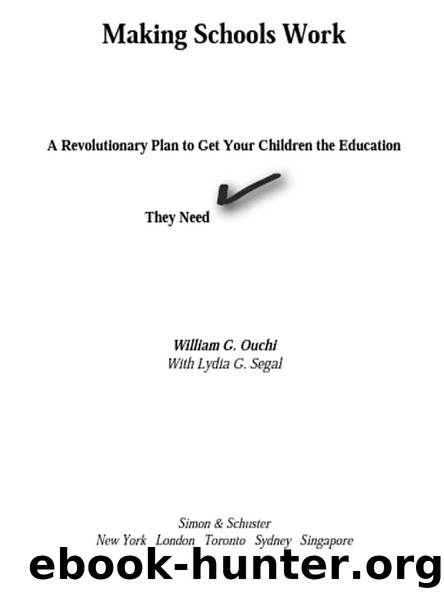Making Schools Work by William G. Ouchi

Author:William G. Ouchi
Language: eng
Format: epub
Tags: SOC035000
Publisher: Simon & Schuster
Published: 2003-07-15T00:00:00+00:00
In the early years, Warman asked the teachers to perform the analysis of the test results themselves, but data analysis just wasn’t their cup of tea. Now, she does the analysis, and the teachers come up with the plan. The plan is implemented the following year, supported by the budget allocations—all of it done locally, without the need for permission from anyone above.
Fine-tuning the curriculum turns out to be as much art as it is science, though, and there are always surprises: “One year we worked on sentence structure and content scores went down. Then we worked on content, and vocabulary went down!” Curriculum, teacher training, and budget are intimately connected at Rideau Park School. For example, the teachers decided on a balanced literacy approach that combines phonics training with whole language—much like they did in District 2—and the school spent $1,200 per teacher for training. Warman can’t come up with this kind of money and paint or recarpet her whole school in one year, so she paints one classroom per year and changes one carpet per year. A central office planner might find that an awfully inefficient way to get a school painted, but Edmonton Public has such a small central office staff that there aren’t any bureaucrats who have time to sit around and question things like that.
Now, here comes the really innovative and impressive part of Rideau Park School: every student who tests below grade level has an individual program. All Alberta students take a second standardized test, the Highest Level of Achievement Test (HLAT). The HLAT provides a different type of score than the Alberta test. It places each student’s score on, above, or below where they should be for their grade level. If a fourth grader receives a math score of 4.2, for example, it means that the student is above grade level. A score of 4.0 would be exactly at grade level.
In all public schools in the United States and Canada, a student who is identified through evaluations as a special needs or special education student must have an Individualized Education Plan, or IEP. In Canada, it’s called an IPP, or Individualized Program Plan. However, Rideau Park Elementary also prepares an IPP for every one of the fifty students who test below grade level on the HLAT. The school focuses on those children who have fallen slightly behind and gives them special attention so that they won’t fall farther—and perhaps become dropouts one day. Parents must sign the plan, and each such student then goes to special classes, has tutoring, and gets whatever help he needs to get back on track.
You’ll surely want to find out what your school is doing to identify weaknesses in its program and to remedy those weaknesses, including how it identifies and assists students who are in danger of falling behind. Once the principal and teachers in your school realize that you know what questions to ask—again, politely—they’ll come up with answers for you. If you don’t ask, though, they’re likely to continue business as usual, with the same results as before.
Download
This site does not store any files on its server. We only index and link to content provided by other sites. Please contact the content providers to delete copyright contents if any and email us, we'll remove relevant links or contents immediately.
Weapons of Math Destruction by Cathy O'Neil(5830)
Cracking the GRE Premium Edition with 6 Practice Tests, 2015 (Graduate School Test Preparation) by Princeton Review(4044)
What It Really Takes to Get Into Ivy League and Other Highly Selective Colleges by Hughes Chuck(3552)
Fooled by Randomness: The Hidden Role of Chance in Life and in the Markets by Nassim Nicholas Taleb(2860)
The Tyranny of Metrics by Jerry Z. Muller(2847)
The Marketing Plan Handbook: Develop Big-Picture Marketing Plans for Pennies on the Dollar by Robert W. Bly(2795)
Ultralearning by Scott Young(2730)
The Official Guide for GMAT Review 2015 with Online Question Bank and Exclusive Video by Graduate Management Admission Council (GMAC)(2643)
50 Economics Classics by Tom Butler-Bowdon(2409)
The Visual MBA by Jason Barron(1979)
The Inevitable by Kevin Kelly(1834)
Data Science for Business by Foster Provost & Tom Fawcett(1812)
Out of the Crisis by Deming W. Edwards(1759)
GMAT Official Guide 2018 Verbal Review by GMAC (Graduate Management Admission Council)(1703)
Cracking the LSAT, 2012 Edition by Princeton Review(1688)
The Personal MBA: Master the Art of Business by Josh Kaufman(1647)
The Conflict Resolution Phrase Book by Barbara Mitchell & Cornelia Gamlem(1646)
Maths and Stats for Web Analytics and Conversion Optimization by Himanshu Sharma(1564)
College Essays that Made a Difference by Princeton Review(1550)
